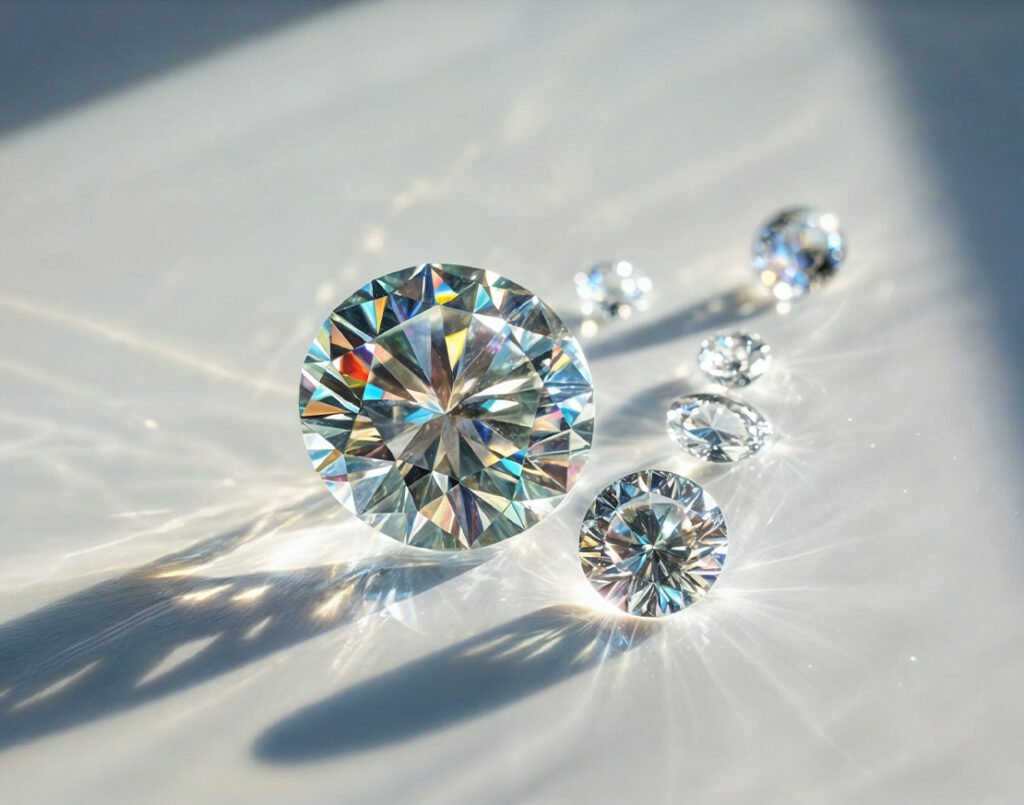In today’s jewelry market, the ethical implications of purchasing diamonds have become more prominent than ever. The term “blood diamonds” has come to symbolize the exploitation and violence often associated with diamond mining, particularly in conflict zones. On the other hand, lab-grown diamonds offer a sustainable and ethical alternative, allowing consumers to enjoy the beauty and brilliance of diamonds without contributing to human suffering or environmental degradation. In this article, we explore the stark contrasts between blood diamonds and lab diamonds, highlighting why lab-grown diamonds have emerged as the ethical choice for modern consumers.
What Are Blood Diamonds?
Blood diamond, also known as conflict diamonds, are diamonds that are mined under conditions that involve severe human rights abuses, child labor, and exploitation in conflict zones. These diamonds are often sold to finance armed conflicts or rebel groups, leading to violence, poverty, and instability in the countries where they are mined.
The term “blood diamond” was popularized during the late 1990s when it became widely known that diamonds from war-torn countries, particularly in Africa, were being used to fund brutal wars. The issue was highlighted in the 2006 film Blood Diamond, starring Leonardo DiCaprio, which brought global attention to the atrocities associated with diamond mining in countries like Sierra Leone, Angola, and the Democratic Republic of Congo.
The international community responded with the establishment of the Kimberley Process Certification Scheme (KPCS) in 2003. This system was designed to prevent the trade of conflict diamonds by requiring that diamonds be certified as conflict-free before being sold. However, despite these efforts, the effectiveness of the Kimberley Process has been questioned, with concerns about loopholes and inadequate enforcement.
What Are Lab-Grown Diamonds?
Lab-grown diamonds, also referred to as synthetic diamonds or cultured diamonds, are diamonds that are created in controlled laboratory environments using advanced technological processes that replicate the natural conditions under which diamonds form in the Earth. The two primary methods of creating lab-grown diamonds are High Pressure High Temperature (HPHT) and Chemical Vapor Deposition (CVD).
Unlike blood diamonds, lab-grown diamonds are produced without the harmful human rights abuses or environmental destruction associated with traditional diamond mining. They are virtually identical to natural diamonds in terms of chemical composition, appearance, and durability, but they are made with a much smaller environmental footprint.
Lab-grown diamonds are considered a sustainable and ethical choice for consumers who wish to avoid supporting the exploitation and violence linked to blood diamonds. They offer all the brilliance and luxury of natural diamonds, but with the added benefit of being environmentally friendly and conflict-free.
Ethical Issues with Blood Diamonds
1. Human Rights Violations
One of the most concerning aspects of blood diamonds is the severe human rights violations that occur during their extraction. In many conflict zones, workers, including women and children, are subjected to forced labor, dangerous working conditions, and physical abuse. These labor practices are often hidden from the public eye, but they contribute to significant harm to those involved.
2. Funding Armed Conflicts
Blood diamonds are often used to finance rebel groups or warlords in regions suffering from civil unrest. These groups engage in violence and destabilize entire countries, creating widespread suffering. The sale of blood diamonds helps perpetuate these conflicts, making it difficult for communities to recover and rebuild.
3. Environmental Degradation
Diamond mining, especially in conflict regions, can lead to severe environmental damage. The excavation of diamonds often involves large-scale mining operations that strip entire landscapes, destroy ecosystems, and pollute local water supplies. These environmental consequences further exacerbate the hardships faced by local communities.
Why Lab-Grown Diamonds Are the Ethical Choice
Lab-grown diamonds provide a responsible alternative to traditional diamonds by eliminating the ethical and environmental concerns associated with blood diamonds. Here’s why lab-grown diamonds are the ethical choice for conscientious consumers:
1. Conflict-Free
Lab diamonds are produced in controlled environments with no connection to conflict zones or rebel financing. They are certified as conflict-free, meaning that their creation does not contribute to violence or exploitation. For consumers who want to make sure their diamonds have not been associated with human suffering, lab-grown diamonds are the clear choice.
2. Environmentally Friendly
The environmental impact of lab-grown diamonds is significantly lower than that of mined diamonds. Traditional diamond mining involves harmful practices such as open-pit mining, which leads to deforestation, soil erosion, and water contamination. In contrast, the production of lab-grown diamonds requires less land disruption and water use. Additionally, lab-grown diamonds are often created using renewable energy sources, further reducing their environmental footprint.
3. No Human Rights Violations
Unlike blood diamonds, which often involve exploitation and forced labor, lab-grown diamonds are made in ethical working conditions, with fair wages and safety standards for workers. The entire supply chain of lab-grown diamonds is transparent, ensuring that workers’ rights are protected and that no individuals are subjected to abuse.
4. Affordable Luxury
Lab-grown diamonds are typically more affordable than their mined counterparts, offering consumers the chance to own beautiful diamonds at a fraction of the price. This makes luxury jewelry accessible to a wider audience, without compromising on ethics or quality.
Lab-Grown Diamonds vs. Mined Diamonds: Key Differences
While lab-grown diamonds share the same chemical, physical, and optical properties as natural diamonds, there are some key differences:
| Feature | Blood Diamonds (Mined Diamonds) | Lab-Grown Diamonds |
|---|---|---|
| Ethical Concerns | Often linked to conflict, exploitation, and human rights violations | Conflict-free, ethical production |
| Environmental Impact | Significant environmental degradation (e.g., deforestation, water pollution) | Minimal environmental impact, often using renewable energy |
| Cost | Generally more expensive due to mining and transportation costs | More affordable due to lower production costs |
| Sustainability | Unsustainable due to the harmful impact of mining | Sustainable and environmentally friendly |
| Physical Properties | Identical to lab-grown diamonds | Identical to mined diamonds in terms of hardness, brilliance, and appearance |
The Future of Ethical Diamonds
As consumer awareness of ethical issues related to diamond mining increases, lab-grown diamonds are gaining popularity as a sustainable and socially responsible alternative to traditional diamonds. The diamond industry is undergoing a significant shift, with more consumers demanding transparency and sustainability in their purchases. Lab-grown diamonds provide a solution that aligns with these values while still offering the beauty and luxury that people seek.
Companies that prioritize ethical sourcing, sustainability, and transparency in their operations are paving the way for a more responsible future for the diamond industry. Lab-grown diamonds represent a modern approach to luxury, one that does not involve the exploitation of people or the environment.
Conclusion
Blood diamonds are a stark reminder of the human and environmental costs associated with the traditional diamond industry. The ethical issues surrounding blood diamonds, such as human rights violations, funding of armed conflicts, and environmental degradation, have led many consumers to seek out more responsible alternatives. Lab-grown diamonds offer a solution that eliminates these concerns by providing beautiful, conflict-free gemstones that are produced in a sustainable and ethical manner.
For those who wish to make a positive impact with their purchase and avoid supporting unethical practices, lab-grown diamonds are the ideal choice. With their brilliance, affordability, and ethical production, lab-grown diamonds offer a modern solution to the age-old dilemma of how to enjoy luxury without contributing to harm. As more consumers make the switch to lab-grown diamonds, the future of the diamond industry looks brighter, more ethical, and more sustainable.





